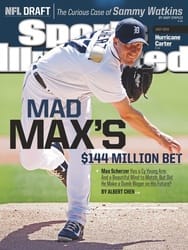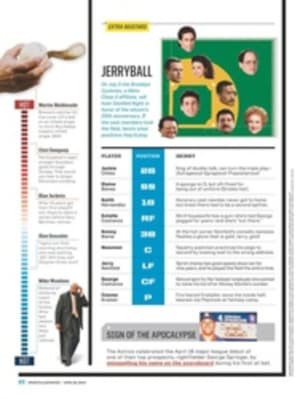MAD MAX
THERE ARE TWELVE possible ball-strike counts in any given at bat in a baseball game. With every pitch the probabilities of that at bat's outcome change, the mathematical odds swinging, sometimes dramatically, in favor of either the pitcher or the hitter. Conventional wisdom has long decreed that the first pitch is the most important move in the chess match—that for a pitcher, throwing a strike on an 0-and-0 count is the most crucial way to take the upper hand.
In 2004, a decade before he would become a Cy Young winner, Max Scherzer was a tall, baby-faced freshman at Missouri, with a blowtorch of a fastball and a tornado of a delivery so raw and violent that often his hat fell off as he unleashed a pitch. His college coaches, preaching the importance of getting ahead of hitters, presented the pitching staff with a packet of historical data that showed that the school's most successful hurlers regularly won the battle of the 1-and-1 count. Scherzer, a finance major with a keen mathematical background—at Parkway Central High in St. Louis, he scored a 35 out of 36 in the math portion of the ACT and graduated with a 3.9 GPA—was fascinated; it was like being let in on a powerful baseball secret. It wasn't the first pitch of an at bat that is the most critical—it was the first three. In fact, no pitch swings the odds more in the pitcher's favor than a strike on a 1-and-1 count.
Of all the numbers from his breakthrough 2013 season—21 wins, 240 strikeouts, 0.97 WHIP, 6.7 WAR, one Cy Young—none satisfied Scherzer more than this: 74.3, his strike percentage in 1-and-1 counts, the highest in the majors. Attack in three pitches: This was Scherzer's core philosophy at Missouri, where in three years he bloomed from a 43rd-round pick into a first-rounder. Now, as one of the best pitchers in baseball, the three-pitch attack is in his DNA. "I don't even think about it—I just do it," he says.
There are two Max Scherzers. There is the one who pitches on instinct and feel, the guy who won't hesitate to dump his curveball in the middle of a game because it doesn't feel quite right. Watching this improviser on the mound—his explosive, unconventional delivery unleashing 99-mph rockets and 86-mph sliders that bend through the air as if they've been CGI'd—is like watching a mad genius at work. This Max is all emotion, with fist pumps and screams back to the dugout after great escapes from perilous situations, such as the one in the eighth inning of Game 4 of last year's ALDS against Oakland. After loading the bases, Scherzer struck out two, got the third out on a fly ball, then went so berserk in the dugout that pitching coach Jeff Jones wondered if Scherzer had broken Jones's hand with a particularly violent fist bump. Catcher Alex Avila calls this version Mad Max.
There is the other Max too: the cerebral, analytical pitcher who might otherwise be making his fortune as a Wall Street trader, the one who brings a mathematical background to the game and is fluent in FIP and BABIP and the rest of the sabermetric universe, but who is also a nuanced enough thinker to debate the best applications of advanced metrics to his performance. This Max is the sharpest knife in the clubhouse.
When the news broke late last month that Scherzer had rejected a bounteous extension offer from the Tigers—a six-year, $144 million deal that would have put him among the game's eight highest-paid pitchers in terms of average annual value—and was headed for the open market after this season, the reaction was generally along the lines of, Mad Max has lost his mind. There was the not entirely surprising reaction of a former player chiming in with incredulous disapproval ("Max Scherzer turned down 6 yrs and 144 mil??? Boras works for u Max, not the other way around!" Chipper Jones tweeted, referring to Scherzer's agent, Scott Boras). But perhaps the most jarring response came from the Tigers' front office, which took the unusual step of releasing a statement to announce a non-signing: Detroit had proposed a "substantial, long-term contract extension" that would have made Scherzer "among the highest paid pitchers in baseball, and the offer was rejected." This is the closest you will get a professional front office to publicly say ... WTF?
It's not an unreasonable question. How could a pitcher fast approaching 30 who until last year had never reached 200 innings, never had a full-season ERA below 3.50 and never even made an All-Star team walk away from $144 million for a bigger payday that wasn't guaranteed? Max Scherzer's Big Bet, however, does not come from an uninformed place; it is rooted in the changing economics of the game that values what Scherzer offers more than ever (sidebar, page 32). It is rooted, too, in a pitcher's deep belief that his best years—many of them—are in front of him.
THE FIRST big bet of Scherzer's baseball career was an easy one. Drafted in the 43rd round in 2003 by the Cardinals, Scherzer turned down his hometown team and chose to pitch in college, where he refined his delivery and learned to harness his fastball. He also learned to appreciate the power of information. His late brother, Alex, a Missouri M.B.A. graduate who passed away in 2012, introduced him to sabermetric analysis. From Missouri coach Tim Jamieson he learned the philosophy of "attacking in three pitches." Jamieson called the approach "A3P," and in recent years the importance of throwing strikes on a 1-and-1 count has become a mantra among big league pitching coaches, notably Tampa Bay's Jim Hickey and Boston's Juan Nieves. Last year batters hit .255 with a .387 on-base percentage after a 2-and-1 count and just .179 and .228 after 1 and 2.
Scherzer acknowledges that he learned the importance of attacking early from advanced stats, but at the same time he doesn't closely track advanced numbers such as fielding independent pitching, or FIP ("Great for understanding the luck inherent in the game—not so useful as a scouting tool to beat the Cleveland Indians," he says), or pitch-tracking resources such as PITCHf/x. ("It's an interesting tool to get information on release points—but if you're looking to make adjustments, nothing beats the human eye.") What the advanced stats have done for Scherzer is help him accept the randomness that permeates the game, to accept that there are many variables beyond a pitcher's control.
"You don't see in the stats [the reward] for executing a slider on a slide step with an absolute burner at first to keep him from stealing second," he says. But, he adds, "the advanced stats are great to look at for my long-term goals and what I'm trying to accomplish. It shows me there is an inherent failure in pitching. The luck involved, the factors you can't control. You just have to let go of those and focus on the next batter, the next game. You can't do anything about bloop hits. I didn't understand that before, and now I do."
"A lot of guys overthink and overcomplicate things," Jamieson says. "Max always had the ability to take all the information, consume it, but simplify things when he's out there."
The Big 12 pitcher of the year as a sophomore in 2005, Scherzer was a first-round draft pick by the Diamondbacks a year later, signing a $4.3 million contract. He was one of the most highly regarded prospects in the Arizona system, but even as the Tigers looked into acquiring Scherzer—he was ultimately included in a three-team 2009 deal among the Yankees, Tigers and Diamondbacks that sent Curtis Granderson to New York, Edwin Jackson and Ian Kennedy to the desert, and Scherzer, Austin Jackson, Daniel Schlereth and Phil Coke to Detroit—the team's scouts were divided on his upside. "I personally was surprised that Arizona would even talk about him in a trade," says Tigers president Dave Dombrowski. "You did hear that they were concerned about his delivery and durability long-term. For us, those were concerns—but we felt comfortable that he would hold up." Some among the Detroit brass thought he could be an All-Star, but far more believed he would be an adequate middle-of-the-rotation pitcher. That's precisely what he was over his first five seasons—a pitcher with a great fastball and an average slider—but things changed two years ago. During a bullpen session in Detroit in the summer of 2012, Scherzer was working with Jones, the Detroit pitching coach, on a secondary pitch to throw to lefthanders, against whom Scherzer had particularly struggled.
Scherzer had not thrown a curveball since high school, with good reason: It did not come naturally to him. The curve, more than any other pitch, can be a freak of genetics, dependent on a God-given snap of the wrist. For a major leaguer, a good curve can be the difference between the top of the rotation and the bullpen. Take the Phillies' Jonathan Papelbon, who has been one of the most successful closers of the last decade. He might have been an ace—his former team, the Red Sox, attempted to convert him into a starter in 2007 but abandoned the effort before the end of spring training—with even an average curveball. His right wrist, however, didn't generate the sharp snap that produces an effective bender. So, heavily dependent upon his fastball and splitter, Papelbon found a more accommodating home in the bullpen.
Jones had some advice for Scherzer: Try throwing a slow breaking ball, and then an even slower one. The ball bit more than he expected.
"Hey, Jonesy," Scherzer said, "what was that?"
"I think you just threw a curveball," said Jones.
Scherzer broke out the deuce a few days later against the Indians and sailed through their lefthanded-heavy lineup. Armed with a vital new secondary pitch, Scherzer became one of the best pitchers in baseball for the rest of 2012, and he believes his '13 season was merely a continuation of that stretch—lefthanders hit just .222 against him a year ago. During the off-season and through the spring, Scherzer's focus has been to refine the pitch that he thinks can further elevate his game.
"I always remember a conversation I had with Dan Haren about his cutter," says Scherzer, who was Haren's teammate in Arizona and watched that one pitch change the trajectory of the righthander's career. "He said it took him three years to really learn that pitch. I think it could be the same with my curve—it's good right now, but it's going to take a lot of time to get better. I'm finding ways I can use it—throwing it for a strike, right underneath the zone, trying to get more bite out of it.
"Forget the record last year, because I'm not doing that again," he says. "If you're talking about pitching, then I feel I absolutely can be a better pitcher."
LIKE HIS ROTATION MATE and buddy Justin Verlander, Scherzer is a visceral marvel, 6'3" and 220 pounds of linebacker-shouldered menace. Scherzer, however, does not share his co-ace's effortless mechanical fluidity. His delivery has always looked like a horrific arm injury waiting to happen. It begins with his glove in front of his face, just below his eyes; his stare is especially startling because he has two different-colored eyes—the right one is light blue, the left a deep brown—because of a genetic disorder. He raises his arms high above his head and, as he lowers them, hides the ball with a delayed trunk rotation. All his stored energy is then released with a violent flourish in which the right arm swings across his body from a three-quarter slot. His head jerks back as the ball is released, like a doll whose neck is about to snap off. The motion is such a storm of rotational velocity that at the end of his follow-through, Scherzer's shoulders are facing first base and his right foot is higher than his head.
There is an assumption that extreme mechanics put a pitcher at risk of injury, but there is no surefire indicator of long-term durability. Many teams passed on White Sox lefthander Chris Sale in the 2010 draft because of his gnarly, jagged delivery; he's finished in the top six in Cy Young voting the past two years and has never been on the disabled list. Tampa Bay's Matt Moore and Oakland's Jarrod Parker have two of the smoothest deliveries in the game; both have undergone Tommy John surgery in the last month.
When it comes to Scherzer's Big Bet, neither the player nor the club will comment about negotiations. Scherzer says, "The public, the reaction, that doesn't faze me. It's 2014 and we have a great team. Walking into this clubhouse with all these great players makes it great to show up every day to work. All of the off-field stuff, I can promise you, it doesn't even register with me." But Scherzer's mind does not close itself off to the rest of the world. He has read enough to know that he's being called both the smartest man in baseball and also the dumbest for turning down the Tigers' offer. He has set himself up for a chance at a massive payday—perhaps surpassing Verlander's seven-year, $180 million deal, perhaps verging on the record $215 million deal Clayton Kershaw signed with the Dodgers in January. Scherzer's start this season—an 11.3 K/9 rate and a 2.33 ERA despite only one win in four starts—has not hurt his bargaining position.
But Scherzer is also betting that teams will pay him even though he will turn 30 on July 27; Verlander is the only pitcher to land a contract larger than $144 million after his 30th birthday. Scherzer has seen the roll call of pitchers who have undergone Tommy John surgery since the beginning of spring training—there have been at least a dozen. But cerebral Max believes he has an answer for this. "When you look at starting pitchers, once they make it through year four," he says, "then—knock on wood—you see a lot of injury risk go down. You see a lot of young guys getting hurt, and they're under the four-year threshold."
Six months from now, what will he be? The Smartest Man in Baseball? The Dumbest? Either outcome is possible, and Scherzer has accepted that. In the end Max Scherzer's Big Bet is all about his belief in himself—his belief in his work, his belief that he has finally become the pitcher he always knew he could be, his belief that by the end of the season he could be the best pitcher in all of baseball.
In any case, there is no turning back now. Max Scherzer is all in.
He is fluent in FIP and BABIP, but is also a nuanced enough thinker to debate the best applications of advanced metrics to his performance.
He's past his fourth year, so Scherzer believes, "knock on wood—you see a lot of injury risk go down."
PHOTO
Photograph
by ANDREW HANCOCK FOR SPORTS
ILLUSTRATEDSIXPHOTOSJOHN W. MCDONOUGH/SPORTS ILLUSTRATED (SEQUENCE)PHOTOPhotograph by ANDREW HANCOCK FOR SPORTS ILLUSTRATEDMAX EFFICIENCY Violent mechanics and an intimidating stare belie Scherzer's command in crucial counts.PHOTOMARK CUNNINGHAM/MLB PHOTOS/GETTY IMAGES (WITH VERLANDER)MAX PRICE Scherzer is emotional, as he showed in last year's ALDS Game 4, but he is, like co-ace Verlander, in complete control. That will prove very valuable in the next off-season.PHOTOKIRTHMON F. DOZIER/DETROIT FREE PRESS/MCT/LANDOV[See caption above]


